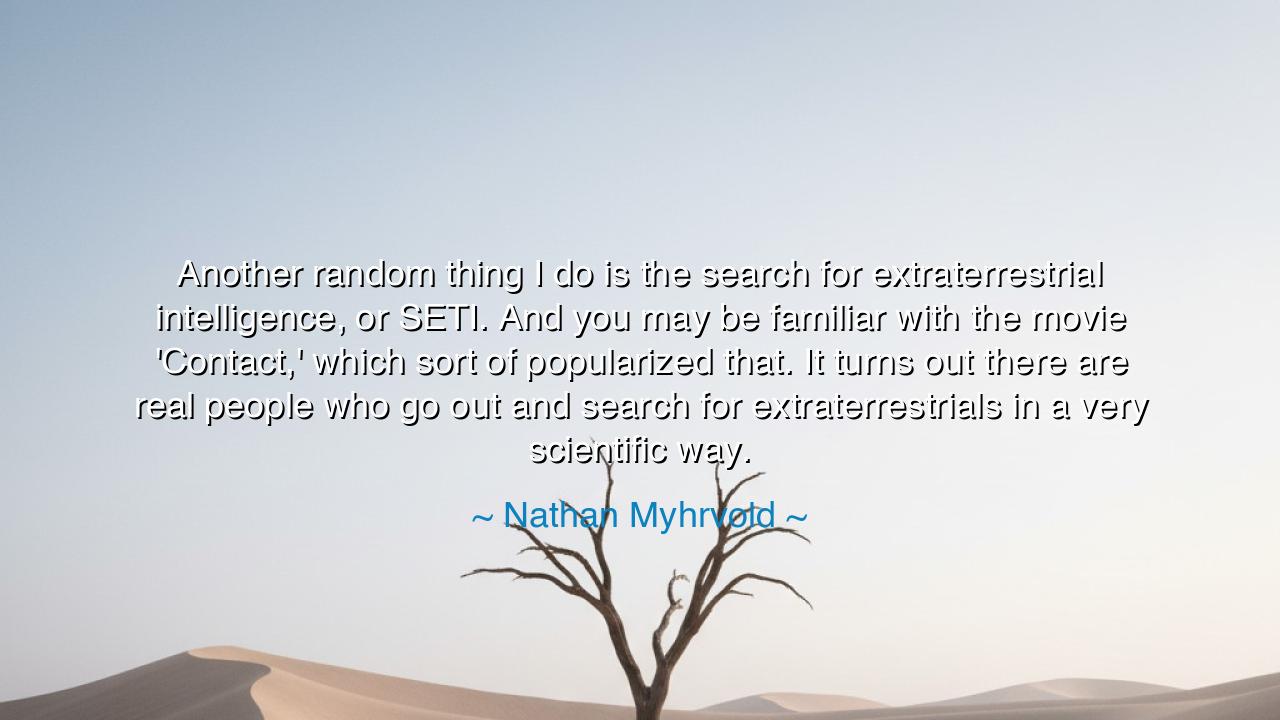
Another random thing I do is the search for extraterrestrial
Another random thing I do is the search for extraterrestrial intelligence, or SETI. And you may be familiar with the movie 'Contact,' which sort of popularized that. It turns out there are real people who go out and search for extraterrestrials in a very scientific way.






The words of Nathan Myhrvold, scientist, inventor, and visionary thinker, echo with both curiosity and humility: “Another random thing I do is the search for extraterrestrial intelligence, or SETI. And you may be familiar with the movie ‘Contact,’ which sort of popularized that. It turns out there are real people who go out and search for extraterrestrials in a very scientific way.” Beneath this calm and almost casual statement lies the ageless yearning of humanity — the desire to know whether we are alone in the vast cathedral of the cosmos. It is not a mere hobby he describes, but a modern continuation of one of the oldest impulses of the human spirit: the search for connection beyond the stars.
The origin of this quote arises from Myhrvold’s lifelong devotion to the pursuit of knowledge. As a scientist of rare imagination — one who helped shape the digital age and later turned his mind to the mysteries of nature and the universe — his fascination with SETI, the Search for Extraterrestrial Intelligence, reflects a mind unbounded by the ordinary. When he speaks of “real people” who search for extraterrestrials “in a very scientific way,” he bridges the worlds of myth and reason. He reminds us that the dream of contact, once the domain of poets and mystics, now lives within the laboratories and observatories of scientists, armed not with superstition, but with mathematics, radio telescopes, and the disciplined wonder of inquiry.
Yet though the tools have changed, the yearning is ancient. Long before modern science was born, humankind looked upward with awe and asked the same question: Who else is out there? The philosophers of Greece, the astrologers of Babylon, and the astronomers of the Islamic Golden Age all pondered the same mystery. In the Renaissance, Giordano Bruno dared to proclaim that every star in the sky was a sun, each with worlds of its own — and for this belief, he was burned at the stake. But even in his death, his vision lived on, for it captured the eternal flame of curiosity that no darkness could extinguish. In Myhrvold’s words, that flame burns still, refined by science, yet driven by the same cosmic longing.
The mention of the film “Contact” in Myhrvold’s quote is no coincidence. That story, inspired by the work of astronomer Carl Sagan, stands as one of the great parables of the modern age — a hymn to the harmony of faith and reason. In Contact, the protagonist, a scientist, listens to the stars with devotion akin to prayer, seeking proof that intelligence exists beyond Earth. When she finally finds it, the revelation challenges not only science, but humanity’s very sense of purpose. Myhrvold invokes this tale to remind us that SETI is not the pursuit of fantasy, but of perspective. It is a mirror held up to our species, forcing us to confront our own smallness and potential in the same breath.
For though we search the heavens for other minds, the act itself teaches us much about our own. The search for extraterrestrial intelligence is, in truth, a search for meaning — for belonging in an infinite universe that seems both wondrous and indifferent. It asks: if we are not alone, how should we live? And if we are, what responsibility do we bear toward the fragile blue world that cradles us? The scientist who turns his telescope skyward participates in the oldest of human rituals: not the worship of gods, but the worship of understanding — the reverent act of listening for truth in the silence between the stars.
History reminds us that progress is born from such curiosity. When Galileo Galilei raised his telescope to the night sky, he shattered the illusion that Earth was the center of creation. When NASA’s Voyager spacecraft left our solar system carrying the golden record — a message to unknown civilizations — humanity, for the first time, sent its voice into eternity. Myhrvold’s quote belongs to this lineage. His words, modest in tone, conceal the grandeur of a quest that spans centuries — the belief that knowledge and wonder walk hand in hand, and that to seek is to live.
And so, my children, let this be your lesson: never allow the boundaries of the known to imprison your imagination. Be like Myhrvold and those who labor in silence, listening to the stars. The search for truth, whether in the cosmos or within your own heart, requires patience, discipline, and faith. To ask a question that may never be answered is not folly — it is the noblest act of courage. When you look up at the night sky, remember that every spark of light is a possibility, every mystery an invitation. The true extraterrestrial intelligence we may one day discover might not only exist in some distant galaxy, but in the awakened mind of humankind itself — the mind that dares to dream, to seek, and to understand.
For as Nathan Myhrvold teaches, the search for life beyond our world is more than science — it is a reflection of the spirit that defines us. It is proof that even in an age of data and devices, the heart of humanity still beats with wonder. Look to the stars, then, not with fear or arrogance, but with the humility of seekers and the strength of builders. For one day, whether we find life among the stars or not, we shall find in ourselves the greatest intelligence of all — the will to keep searching.






AAdministratorAdministrator
Welcome, honored guests. Please leave a comment, we will respond soon